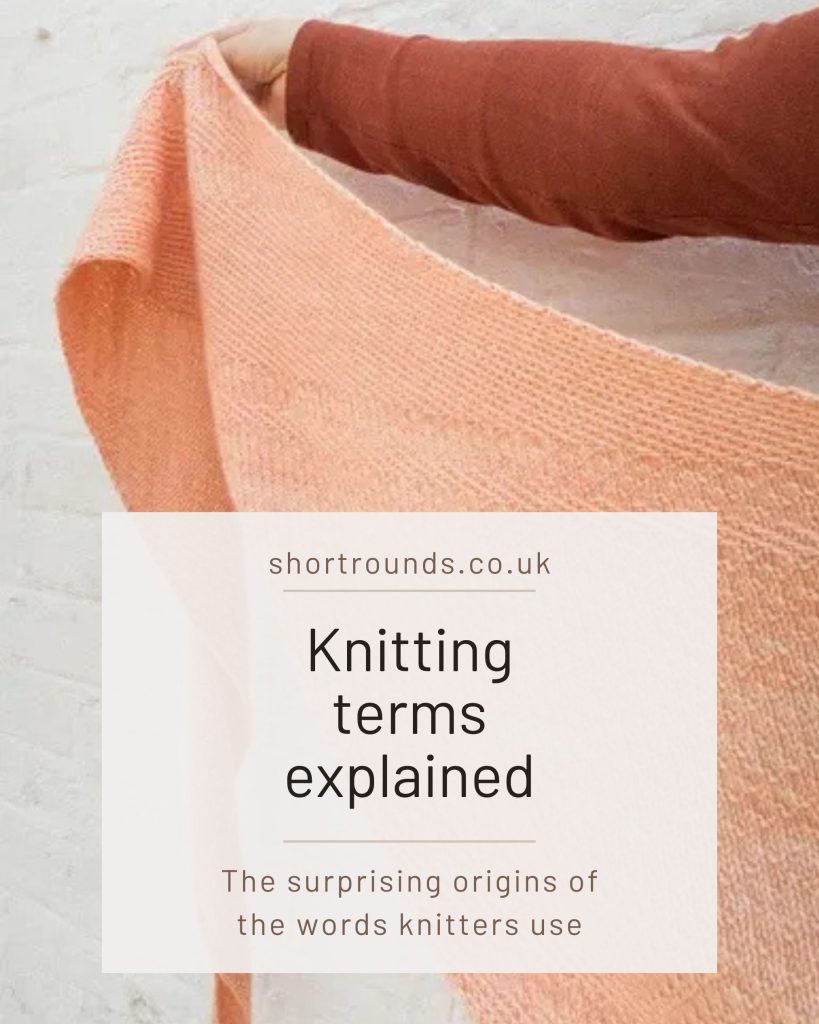Or…the surprising origins of the words knitters use
I’ve been knitting for more years than I care to count, let alone commit to writing where someone might quote me on it. Over the years, I’ve adopted the knitter’s vernacular so wholeheartedly that I sometimes forget that normies have absolutely no idea what I’m on about. Friends stare at me like I’ve sprouted dpns from my forehead when I say I had to frog my latest cardigan back eight inches, or when I breezily announce, “I’ve only got to block it and then it’s done.”
But every now and again, the English Literature student in me stirs and I start questioning the curious language we knitters toss around without a second thought. When did we start saying “purl” or “notions” or “frogging”… and why, exactly?
Knitting terms form a language all their own. One that’s steeped in history and hands-on tradition (and you’ve got to love our knitting community’s penchant for a bit of eyebrow-raising linguistic mischief). So I thought I’d put together a little glossary to explain the most common knitting terms, from “skein” to “frogging”, and the stories behind them – helpful to both those new to knitting or fluent in fibre-speak.
Skein (n.)
Origin: c. 1400s
Etymology: Middle English skeine, via Old French escaigne. Possibly related to the Norse skēn (to weave or twist).
A skein is a twisty-turny hank of yarn, plaited up to keep things tidy before you open it up and get knitting. The word sounds suspiciously like something Shakespeare might’ve thrown into a sonnet (“…my love is like a skein unraveled…”), and in a way, he wouldn’t be wrong. I love a skein of yarn, there’s something ever so satisfying about unraveling that hank and winding it up into a neat little ball ready to cast on.
Notions (n.)
Origin: 1700s (U.S.)
Etymology: 18th-century American English, meaning “clever ideas or inventions.”
In the US, “notions” referred to small items sold in dry goods stores. Somewhere along the way, crafters claimed the term for all the bits and bobs that keep us from descending into yarn mayhem: stitch markers, row counters, darning needles, that one tape measure that always goes missing.
It’s delightfully vague. Notions implies a sort of magical miscellany. Like you’re Mary Poppins, but your carpet bag is full of needle stoppers and hope.
Knit (v./n.)
Origin: Before 1000 AD
Etymology: From Old English cnyttan, meaning “to tie in a knot.”
You read that right. Knitting’s oldest root is knotting. Which makes sense really, when you consider that every stitch is a loop tied into another. We’ve come a long way since knot-tying turned into sweater-making, but the essence remains: a series of tiny interconnections holding everything together.
Just like us lot, eh?
Purl (v./n.)
Origin: 1500s
Etymology: Possibly from Middle English pirlyng, meaning to twist or twirl.
Oh, the purl stitch. I’m not the biggest fan honestly. Maybe it’s the left-hander in me. It’s slightly fussier than its smooth sibling, the knit stitch, but it still carries its weight in lovely textured bumps. So now you know – “twist” – and I suppose the act of creating the stitch is exactly that.
Fingering (adj., yarn weight)
Origin: Late 1800s–early 1900s
Etymology: Named for its suitability for fine, delicate work, often handled between the fingers (a touch obvious, but we’ll allow it).
This one tends to raise the odd eyebrow, especially when uttered out loud in public. But fingering weight yarn is a classic. It’s light, versatile, ideal for socks, shawls and heirloom pieces. It’s the featherweight boxer of the yarn world: elegant, drapey and deceptively strong.
Blocking (v.)
Origin: 1800s (adopted from tailoring)
Etymology: From “block” as in mould or shape, think millinery or hat blocks.
Blocking is the part we sometimes whisper about like it’s the dark arts, but it’s really just a glorified steam bath for your stitches. A little soak, a gentle stretch, some careful shaping and suddenly, that suspiciously cropped cabled sweater is a glorious, slouchy winter knit!
Frogging (v.)
Origin: 1990s (slang popularised online)
Etymology: A punny delight, from the phrase “rip it, rip it,” which sounds suspiciously like a frog’s ribbit. Yes, really.
To frog is to rip back your knitting. Sometimes a few rows, sometimes the whole blooming thing. Usually because of a mistake you’ve only just noticed, or a sudden, horrifying realisation that your sleeve is shaped like a balloon.
Frogging is a serious power move in knitting disaster management. It’s what separates the seasoned knitter from the “it’ll probably block out” optimist. It’s a declaration: This will not stand, not on my needles, thank you very much.
If you’re lucky enough to have not experienced it first-hand, the stages of frogging grief include: denial, bargaining, tea, rage, acceptance, and eventually… pride.
Gauge (n.)
Origin: Mid-1800s
Etymology: From Old French gauge (a standard or measure), likely through industrial and tailoring use. First applied to knitting as the number of stitches and rows per inch.
Gauge is the maths of knitting. It’s the tension at which you knit (the number of stitches and rows per inch) and it determines whether your finished jumper fits like a dream or ends up fit for an unusually stylish garden gnome.
It’s not the most glamorous stage of the knitting process, but it is a crucial one. Checking your gauge before starting a project makes sure your stitches match the pattern’s scale. Ignore it, and you’re basically flying blind with a pair of pointy sticks.
Most modern patterns list gauge in the materials section (usually over a 10x10cm swatch, worked flat, unblocked or blocked as specified). And it does matter. Even in scarves. And if you’re one of those knitters who casts on a sweater without swatching for gauge… I honestly can’t decide whether to salute you, or swat you over the head with my notions pouch.
What are your favourite (or most confusing) knitting terms?
Ever tried explaining “frogging” to a non-knitter and watched their face do that slow, confused melt? Let me know – my goal is to gather enough knitting linguistic lore to create a thesaurus.
Beth x


